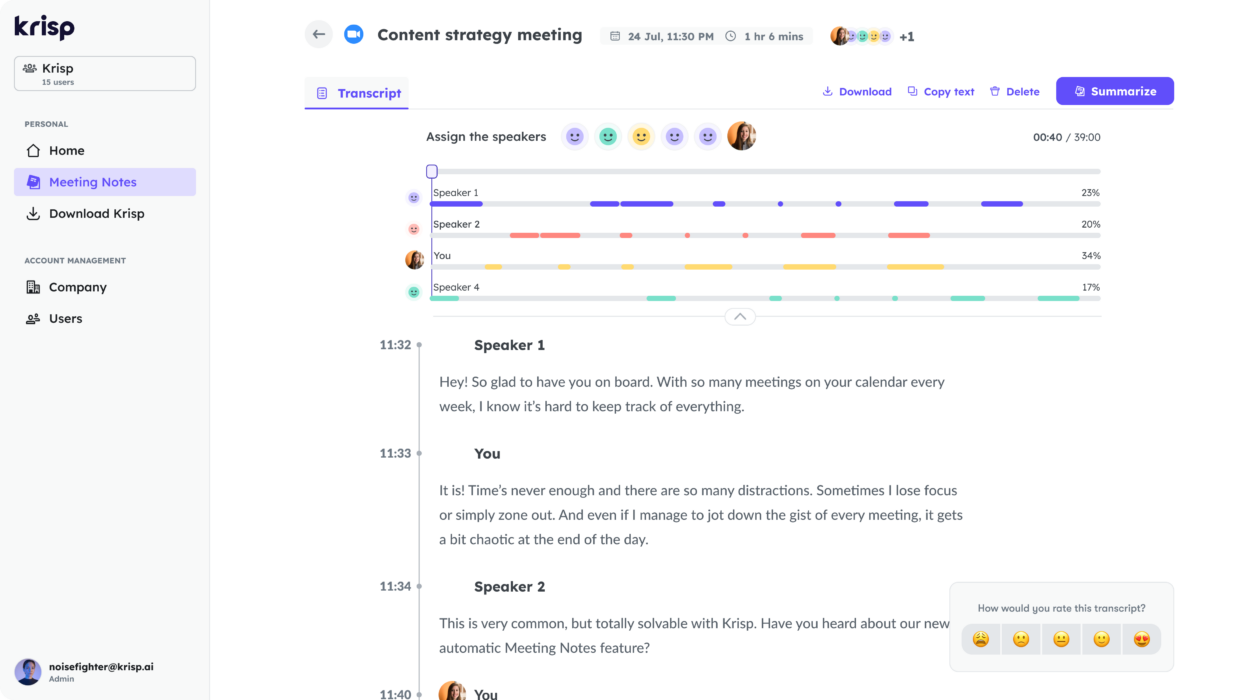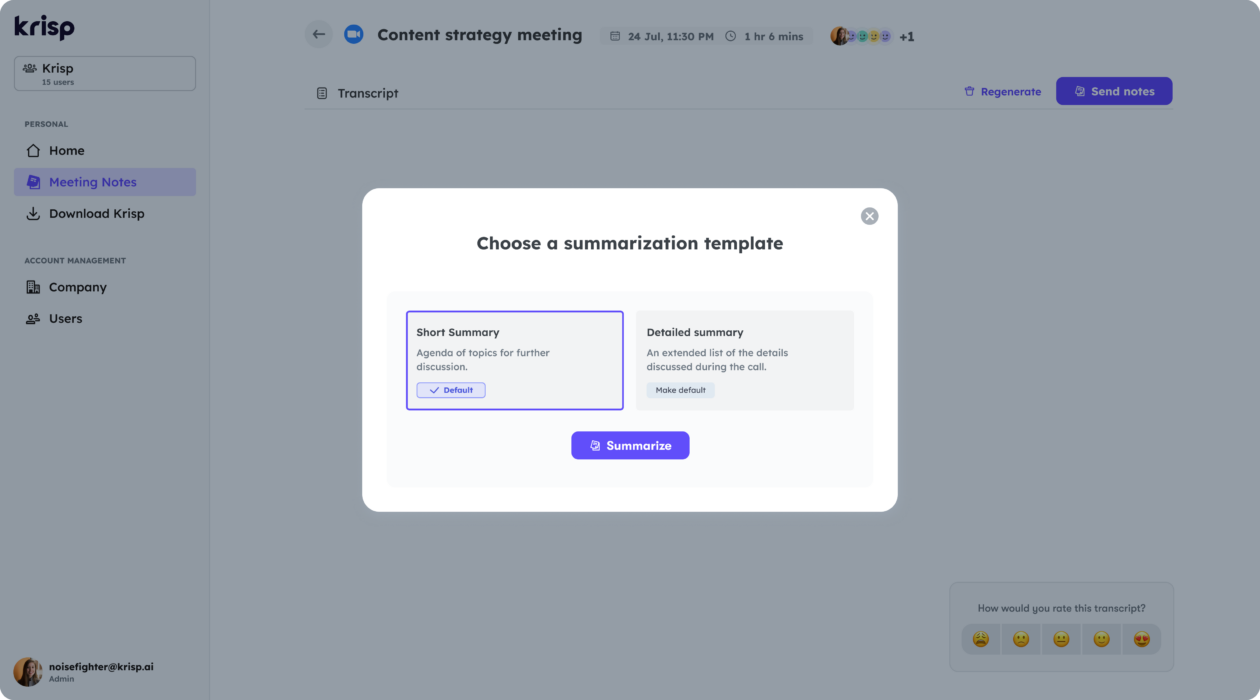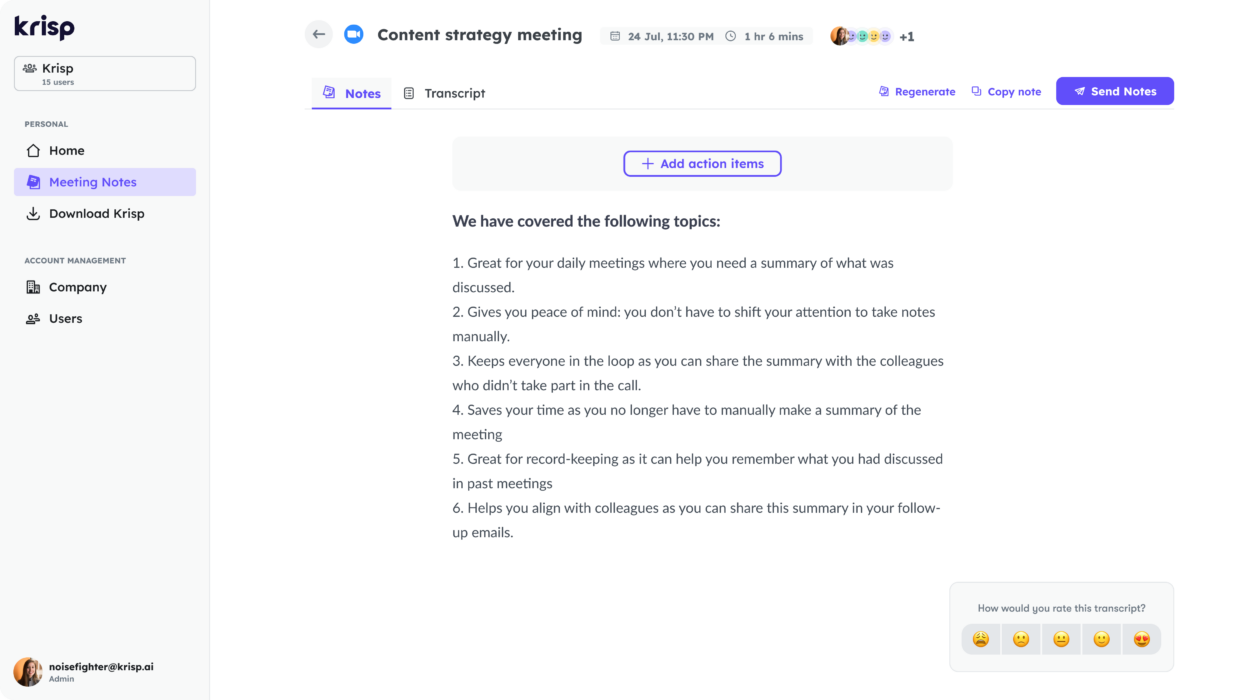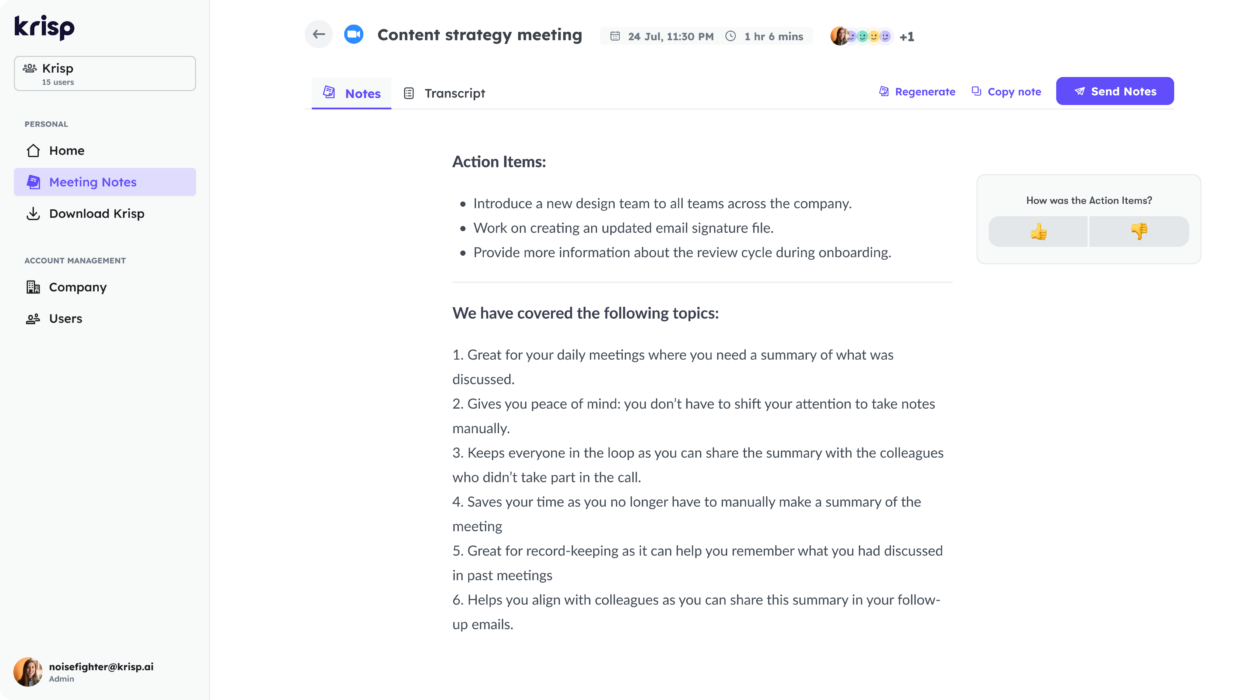Learning how to write a meeting summary is a crucial skill, especially for people that regularly attend or lead meetings.
Keeping track of everything discussed and decided in meetings can sometimes be daunting. This is why knowing how to effectively summarize your discussions and key action items for future reference is important.
This blog post comprehensively takes you through all you need to know about writing online meeting summaries by highlighting:
- Why you should pay more attention to effective meeting summaries;
- Comparing meeting summaries with meeting minutes;
- How to write a meeting summary like an expert;
- Templates and real-life examples.
What is a Meeting Summary?
A meeting summary is a concise and condensed recap of the key discussions, decisions, and action items from a meeting. A summary is an overview and does not contain every single word verbatim, as only the important highlights are captured.
Meeting summaries enable the participants and stakeholders to quickly grasp the key discussions. They can be written down in various forms, including brief email updates, bullet-point lists, or summarized documentation, depending on the organization’s preferred format.
A meeting summary should be created and shared with participants and other relevant stakeholders immediately or shortly after the meeting. This is mainly because the details are still fresh in their minds, and internalizing the context becomes much easier.
In most cases, the person leading the meeting is the one that usually takes notes. However, some organizations may designate a specific individual to jot down the notes. But what can you do if you are overwhelmed with taking notes of the meeting and running it?
Read on to find out how Krisp AI Meeting Assistant can help you seamlessly take and organize your online meeting summaries.
Advantages of Taking Meeting Summaries
Learning how to write effective meeting summaries has numerous benefits, including:
Clarity
Meeting summaries distill complex discussions into concise information. By condensing lengthy conversations, you can get a structured and focused overview of the discussions, eliminating confusion and boosting clarity.
Effective communication
Meeting summaries are an effective communication tool, allowing information to be disseminated efficiently to the participants and other relevant stakeholders.
Time efficiency
A meeting summary makes it easy to quickly scan and focus on the important details instead of reviewing the entire meeting transcript or listening to a recording of the meeting to highlight the key discussion and action items,
Enhanced accountability
Meeting summaries outline action items, responsibilities, and deadlines. This makes them a tangible record of commitments made during meetings, enabling more effective follow-ups and accountability.
Remote collaboration
Teams working remotely or having a hybrid virtual meeting can benefit greatly from meeting summaries. A summary ensures that everyone is well-aligned with the discussions and decisions, regardless of where they are.
Meeting summaries are versatile tools offering numerous advantages beyond immediate communication and productivity improvements. This makes them a valuable asset for various aspects of organizational operations and growth.
Meeting Summary vs Meeting Minutes
Meeting summaries and meeting minutes are commonly used in the realm of business meetings. Although most people use these two terms interchangeably, they have a distinct difference.
Here are some of the key differences to enable you to know which of the two to use during your next meeting:
- Meeting nature: Formal and complex meetings require detailed meeting minutes, while routine team update meetings can benefit from meeting summaries. A good meeting minutes app can seamlessly curate the right structure to follow when documenting your meeting.
- Audience: If the recipients of the documentation are internal team members or during a catch-up meeting, then a meeting summary is more practical. However, you may have to curate meeting minutes if external stakeholders will need to access the documentation.
- Level of detail: Meeting minutes are often more detailed, highlighting various aspects of the meeting as it progresses. However, meeting summaries only offer an overview of the most important discussions and action items.
- Tone: Meeting minutes are often used for legal and compliance purposes. This means they have to be written in a more formal tone. However, when writing summaries, the note-taker can use informal terminologies or paraphrase terms for clarity.
Bonus tip: Try an AI meeting note taker that summarizes your meeting discussions in a formal, easy-to-understand language and saves time.
Tips for Writing Meeting Summaries Like a Pro
Do you want to learn how to write a meeting summary like a pro? Here are a few quick tips to get you started:
Start with a clear objective
It is crucial that you have a clear understanding of what to expect during the meeting.
One way to do this is to have an effective meeting agenda that you can follow, enabling you to know the expected discussions. This allows you to determine where the important discussions take place that you need to jot down.
Moreover, having a clear agenda for the meeting allows you to structure and organize your meeting summary in a logical manner that is easy to understand and with a good flow.
Actively listen and take comprehensive notes
Being actively present during the discussions lets you grasp essential discussions and decisions. This is also beneficial as part of virtual meeting etiquette tips, as active participation in meetings makes them more productive.
Focus on the agenda and highlight the key points, decisions, and action items. Ensure to seek clarity if you do not understand some context.
Only focus on essential details
A meeting summary only entails the key highlights and discussions. You don’t have to jot down everything mentioned but only stick to the main discussions, decisions, and action items.
However, if you prefer to document everything said during the meeting, meeting transcriptions are a better option.
Be objective and neutral
Just like when taking meeting notes, maintain a neutral tone and avoid personal biases or subjective interpretations of the discussions.
Always present the facts as they are, accurately and impartially, enabling the readers to form their own understanding of the discussions and outcomes.
Review and edit
Before finalizing your meeting summary, it would be prudent to take some time to review and edit it for accuracy and clarity.
If you used informal terminologies or abbreviations that your teammates may not comprehend easily, ensure to switch to phrasing they would understand.
Timelines and distribution
Aim to finalize the meeting summary as soon as possible after the meeting ends. You should promptly share the finalized document with relevant stakeholders when the discussions are still fresh. This is also helpful when the participants have faced virtual meeting fatigue.
Ensure everyone stays informed and can take the appropriate actions without delay.
Use meeting summary templates.
A meeting summary template saves you the time you would have spent organizing and structuring your summaries for readability.
Using these templates, you can clearly structure your summaries, as you will know what information to note down and where to do so in the document.
How to Create Meeting Summaries Fast With Krisp
There are two main types of meeting summaries: a comprehensive summary and a condensed summary.
A comprehensive summary provides a detailed account of the meeting proceedings, capturing all key discussions, decisions, action items, and supporting information. This type of summary covers each agenda item and thoroughly records what transpired during the meeting.
On the other hand, a condensed summary focuses on capturing the essential points, decisions, and action items from the meeting. It aims to provide a concise overview of the key takeaways and outcomes, enabling recipients to quickly grasp the main points without delving into every detail.
Krisp allows you to create either a comprehensive or a condensed meeting summary, depending on your needs. It integrates seamlessly with popular platforms like Zoom, Google Meet and Microsoft Teams to generate AI notes and accurate summaries no matter where your meetings take place. Here’s a step-by-step guide on using Krisp to generate meeting summaries like a pro:
Get your transcription

Head over to your Krisp dashboard and select the transcription that you wish to summarize. You can edit the speaker names or review for clarity.
Choose a summary template

Once you click on “Summarize,” you will get a prompt asking you to choose between a short summary (which is the condensed version) or a detailed summary (which has comprehensive details of the meeting discussions).
In this case, we’ve selected “Short Summary.”
Review the key discussion points

Krisp automatically uses its AI capabilities to generate short and concise meeting highlights. You can edit, add, or delete the necessary details.
Add action items

You can include action items in the summary by hitting the “Add Action Items” button. You can repeat the same process if seeking for a more detailed summary, which can be generated within seconds.
Solving Pain Points with Krisp: Automated Transcription and Summarization for Seamless Meeting Sharing
Mastering the skill of writing meeting summaries is crucial for effective communication and productivity in today’s fast-paced work environment. While the tips above can help you take meeting summaries like a pro, it is a no-brainer that taking manual meeting summaries can be time-consuming and prone to human error.
This is where Krisp – an AI tool for meetings, comes into play. Krisp offers a range of benefits for individuals and teams who seek efficient and accurate meeting summaries.
Krisp’s ability to transcribe online meetings verbatim is a game-changer. By automatically generating detailed transcriptions with speaker identification, Krisp ensures an accurate record of all discussions and interactions during the meeting.
In addition, Krisp goes a step further by providing AI-generated summarized versions of the transcriptions.
Whether you prefer a comprehensive and detailed summary or a condensed and concise one, Krisp captures meeting notes from the key discussions, decisions, and action items, saving you valuable time and effort.
With Krisp, you can focus on actively participating in the meeting and engaging with colleagues, knowing that a reliable summary will be available afterward.
To explore more tools that can help you capture and organize meeting notes effectively, check out our comparison of the best AI note taker apps. It’s a practical resource to see how different solutions approach meeting summaries, note-taking, and action item tracking.
Grab this free 7-day pro trial and try Krisp today!
Frequently Asked Questions
How do I structure an online meeting summary effectively?
To structure an online meeting summary effectively, it is crucial to clearly outline the objectives before the meeting. You can also break down the summary into sections and arrange the information in a logical manner.
Should I include direct quotes or phrases in an online meeting summary?
Including direct quotes or phrases in an online meeting summary is unnecessary, as you only need to paraphrase and condense the key discussions.
How can I ensure accuracy in my online meeting summary?
To ensure accuracy in your online meeting summaries, it is important to actively listen during the meeting and review the write-up before sharing it with other stakeholders.
How long should an online meeting summary typically be?
The length of an online meeting summary can vary depending on the nature and complexity of the meeting. Generally, it is best to aim for a concise summary that captures the key points and outcomes.


